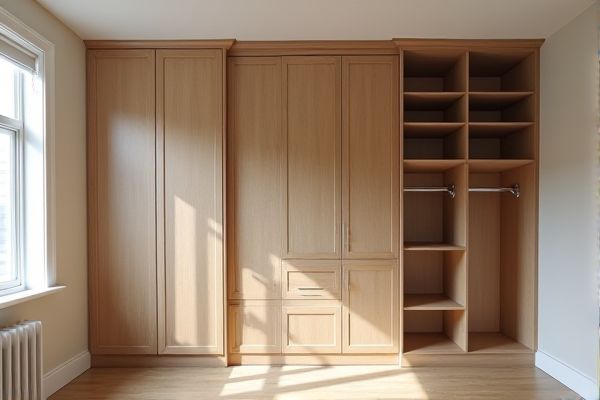
Closet cubbies offer open, organized spaces that make it easy to see and access your belongings, enhancing convenience and visual appeal, while closed cabinets provide a more polished look and protect items from dust and clutter. Discover which storage solution best fits your needs by exploring the full comparison in the article.
Table of Comparison
| Feature | Closet Cubbies | Closed Cabinets |
|---|---|---|
| Accessibility | Open design for quick access | Doors provide enclosed storage |
| Visibility | Items visible and easy to locate | Items hidden behind doors |
| Dust Protection | Low protection, items exposed | High protection from dust and dirt |
| Organization | Fixed or customizable compartment sizes | Flexible shelving with adjustable heights |
| Aesthetic | Casual, open look | Clean, streamlined appearance |
| Maintenance | Requires frequent dusting | Less frequent cleaning needed |
| Cost | Typically lower cost | Generally higher cost |
| Best For | Visible storage, quick grab items | Hidden storage, preserving item condition |
Introduction to Closet Cubbies and Closed Cabinets
Closet cubbies offer an open storage solution with individual compartments ideal for organizing shoes, accessories, and folded items, promoting easy visibility and access. Closed cabinets provide concealed storage options that protect belongings from dust and maintain a sleek, uniform appearance, often featuring doors and shelves for versatile organization. Both options cater to different storage priorities, balancing accessibility with aesthetics and protection.
Design Differences: Open vs. Closed Storage
Closet cubbies feature open storage design that allows easy access and visibility of items, enhancing organization and quick retrieval. Closed cabinets offer concealed storage, protecting belongings from dust and creating a streamlined, clutter-free appearance. Your choice between the two depends on balancing accessibility with aesthetic preferences and storage needs.
Organization and Accessibility
Closet cubbies offer open compartments that enhance visibility and quick access to items, making organization straightforward and efficient. Closed cabinets provide concealed storage, protecting belongings from dust and creating a streamlined appearance but can limit immediate accessibility. Choosing between cubbies and closed cabinets depends on prioritizing easy reach versus a tidy, clutter-free look.
Visual Appeal and Aesthetic Impact
Closet cubbies offer an open, airy design that enhances visual appeal by showcasing your organized belongings, creating a dynamic and personalized aesthetic in your space. Closed cabinets provide a sleek, minimalist look that conceals clutter, promoting a clean and streamlined environment ideal for a modern aesthetic. Your choice between cubbies and cabinets will influence the overall ambiance, balancing openness with orderliness to suit your design preferences.
Space Utilization and Layout Flexibility
Closet cubbies maximize space utilization by offering open, accessible compartments that accommodate various items while maintaining visibility and organization. Closed cabinets provide a more flexible layout by allowing customization of shelves and doors, enabling users to hide clutter and tailor storage to specific needs. Both systems optimize space differently, with cubbies excelling in easy access and open storage, while closed cabinets enhance aesthetic appeal and adaptability.
Maintenance and Cleaning Considerations
Closet cubbies offer open storage spaces that make dusting and cleaning more frequent but straightforward, as surfaces are easily accessible. Closed cabinets reduce dust accumulation by fully enclosing items, minimizing the need for regular deep cleaning inside. Your choice depends on whether you prefer quick, routine cleaning or less frequent, more thorough maintenance.
Cost Comparison: Cubbies vs. Cabinets
Closet cubbies typically cost less than closed cabinets due to simpler construction and fewer materials used. Closed cabinets require additional components like doors, hinges, and handles, increasing overall expenses and installation complexity. Budget-conscious homeowners often prefer cubbies for affordable storage solutions without compromising organization.
Suitability for Different Spaces and Needs
Closet cubbies offer open, easily accessible storage ideal for small spaces and frequent use, making them suitable for organizing shoes, bags, and accessories in compact areas. Closed cabinets provide a more polished look with concealed storage, perfect for larger rooms or when a tidier appearance is desired, effectively protecting items from dust. Choosing between cubbies and cabinets depends on space constraints, organizational needs, and aesthetic preferences, balancing visibility with cleanliness.
Durability and Material Options
Closet cubbies typically feature open shelving made from materials like wood, laminate, or wire, providing easy access but potentially less protection against wear and dust compared to closed cabinets. Closed cabinets often use solid wood, MDF, or metal with finishes that enhance durability and protect contents from damage and dirt. Your choice depends on whether you prioritize material variety and sturdy protection with closed cabinets or the flexibility and accessibility offered by cubbies.
Choosing the Right Storage: Cubbies or Cabinets?
Closet cubbies offer open, easily accessible storage ideal for organizing shoes, accessories, and frequently used items, enhancing visibility and airflow. Closed cabinets provide a sleek, clutter-free appearance while protecting belongings from dust and maintaining a streamlined aesthetic. Selecting the right storage depends on prioritizing accessibility and openness with cubbies or opting for a polished, concealed look with cabinets.
 homyna.com
homyna.com